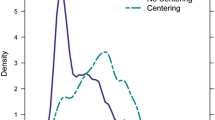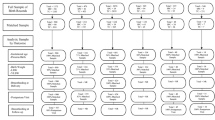Abstract
We examined the effects of CenteringPregnancy group prenatal care versus individually delivered prenatal care on gestational age, birth weight, and fetal demise. We conducted a retrospective chart review and used propensity score matching to form a sample of 6,155 women receiving prenatal care delivered in a group or individual format at five sites in Tennessee. Compared to the matched group of women receiving prenatal care in an individual format, women in CenteringPregnancy group prenatal care had longer weeks of gestation (b = .35, 95 % CI [.29, .41]), higher birth weight in grams (b = 28.6, 95 % CI [4.8, 52.3]), lower odds of very low birth weight (OR = .21, 95 % CI [.06, .70]), and lower odds of fetal demise (OR = .12, 95 % CI [.02, .92]). Results indicated no evidence of differences in the odds of preterm birth or low birth weight for participants in group versus individual prenatal care. CenteringPregnancy group prenatal care had statistically and clinically significant beneficial effects on very low birth weight and fetal demise outcomes relative to traditional individually delivered prenatal care. Group prenatal care had statistically significant beneficial effects on gestational age and birth weight, although the effects were relatively small in clinical magnitude.
Similar content being viewed by others
Notes
This exclusion criterion was used to ensure conservative estimates of effects, such that results would not be biased due to poor birth outcomes among women who did not receive adequate levels of prenatal care over the course of pregnancy. Indeed, at Site B where this exclusion resulted in the loss of 254 cases, CP participants were significantly less likely than traditional care participants to attend fewer than five prenatal care sessions (χ 2 = 7.09, p = .01). Retaining these cases in the analysis sample yielded statistically significant beneficial effects of CP—an effect partly due to bias associated with inadequate prenatal care receipt among traditional care patients. Thus, we used this exclusion criterion to ensure a conservative effect of CP prenatal care on birth outcomes.
Again, the restriction to the common support region was used to ensure conservative estimates of CP effects on birth outcomes, such that CP participants were only compared with traditional care participants with similar background characteristics. Despite the large number of participants dropped at Site C due to propensity score estimates falling outside the common support region, sensitivity analyses (available upon request from the authors) at Site C indicate that all results were substantively unchanged when those 315 participants were retained in the sample. Nonetheless, for all analyses we excluded participants with propensity scores outside the common support region to be consistent with standard propensity score methods and to ensure comparability in the CP and traditional care patients being compared [18].
A many-to-many matching procedure was used given that several of the birth outcomes of interest were rare events and thus particularly difficult to detect in small samples. We therefore aimed to maintain the largest overall sample size possible to maximize statistical power to detect effects for these rare birth outcomes, while simultaneously ensuring that the CP and traditional prenatal care patients that were compared were equivalent in terms of background characteristics.
We include the site-specific models given that some readers may be interested in the effects of CP at sites with particular client profiles/characteristics.
Sensitivity analyses (available from authors) that adjusted for the propensity score and did not include the additional covariates of age, race, and gravidity yielded almost identical substantive and statistical results. These additional covariate controls were retained in all analyses, however, for face validity purposes, particularly given the race differences between CP and traditional prenatal care clients that persisted even after matching (see Table 2).
The beneficial effect of CP on gestational age was indeed significantly larger for women with preterm births, as evidenced by a significant multiplicative interaction term in a model including all participants (b CP = .03, 95% CI = [−.01, .08]; b preterm = −6.86, 95% CI = [−7.10, −6.61]; b CPXpreterm = 2.54, 95% CI = [2.38, 2.71]). The beneficial effect of CP on gestational age was significantly larger for women with low birth weight births, as evidenced by a significant multiplicative interaction term in a model including all participants (b CP = .00, 95% CI = [−.17, .18]; b low birth weight = −5.97, 95% CI = [−6.66, −5.27]; b CPXlow birth weight = 2.37, 95% CI = [2.07, 2.68]).
Note that confidence intervals for birth weight outcomes are wide because birth weight was measured in grams, and due to the imprecision in point estimates at sites with the smallest sample sizes.
Again, the beneficial effect of CP on birth weight was significantly larger for women with preterm births, as evidenced by a significant multiplicative interaction term in a model including all participants (b CP = −16.7, 95% CI = [−34.9, 1.5]; b preterm = −1,307, 95% CI = [−1,437, −1,177]; b CPXpreterm = 372, 95% CI = [275, 469]). The beneficial effect of CP on birth weight was also significantly larger for women with low birth weight births, as evidenced by a significant multiplicative interaction term in a model including all participants (b CP = −29.8, 95% CI = [−39.0, −20.7]; b low birth weight = −1,566, 95% CI = [−1,648, −1,484]; b CPXlow birth weight = 377, 95% CI = [345, 409]).
References
2011 KIDS COUNT data book: State profiles of child well-being. Annie E. Casey Foundation. Accessed 01 March 2011 from: http://datacenter.kidscount.org/databook/2011/stateprofilesheets.aspx.
Alexander, G. R., & Kotelchuck, M. (2001). Assessing the role and effectiveness of prenatal care: History, challenges, and directions for future research. Public Health Reports, 116(4), 306–316.
Allen, J., Gamble, J., Stapleton, H., et al. (2012). Does the way maternity care is provided affect maternal and neonatal outcomes for young women? A review of the research literature. Women Birth, 25(2), S20–S21.
Rising, S. S. (1998). CenteringPregnancy: An interdisciplinary model of empowerment. Journal of Nurse-Midwifery, 43(1), 46–54.
Ickovics, J. R., Kershaw, T. S., Westdahl, C., et al. (2007). Group prenatal care and perinatal outcomes. Obstetrics and Gynecology, 110(2), 330–339.
Kennedy, H. P., Farrell, T., Paden, R., et al. (2011). A randomized clinical trial of group prenatal care in two military settings. Military Medicine, 176(10), 1169–1177.
Ickovics, J. R., Reed, E., Magriples, U., et al. (2011). Effects of group prenatal care on psychosocial risk in pregnancy: Results from a randomised controlled trial. Psychology & Health, 26(2), 235–250.
Bloom, C. K. (2005). Use of the CenteringPregnancy program in a school-based clinic: A pilot study. Clinical Excellence for Nurse Practitioners, 9(4), 213–218.
Grady, M. A., & Bloom, K. C. (2004). Pregnancy outcomes of adolescents enrolled in a CenteringPregnancy program. Journal of Midwifery & Women’s Health, 49(5), 412–414.
Ickovics, J. R., Kershaw, T. S., Westdahl, C., et al. (2003). Group prenatal care and preterm birth weight: Results from a matched cohort study at public clinics. Obstetrics and Gynecology, 102(5), 1051–1057.
Klima, C., Norr, K., Vonderheid, S., et al. (2009). Introduction of CenteringPregnancy in a public health clinic. Journal of Midwifery & Women’s Health, 54(1), 27–33.
Robertson, B., Aycock, D. M., & Darnell, L. A. (2009). Comparison of CenteringPregnancy to traditional care in Hispanic mothers. Maternal and Child Health Journal, 13(3), 407–414.
Picklesimer, A. H., Billings, D., Hale, N., et al. (2012). The effect of CenteringPregnancy group prenatal care on preterm birth in a low-income population. American Journal of Obstetrics and Gynecology, 206(5), 415.e1–415.e7.
Tandon, S. D., Colon, L., Vega, P., et al. (2012). Birth outcomes associated with receipt of group prenatal care among low-income Hispanic women. Journal of Midwifery & Women’s Health, 57(5), 476–481.
Ruiz-Mirazo, E., Lopez-Yarto, M., & McDonald, S. D. (2012). Group prenatal care versus individual prenatal care: A systematic review and meta-analysis. Journal of Obstetrics and Gynaecology Canada, 34(3), 223–229.
Tanner-Smith, E. E., Steinka-Fry, K. T., & Lipsey, M. W. (2012). A multi-site evaluation of the CenteringPregnancy ® programs in Tennessee. Peabody Research Institute, Vanderbilt University. https://my.vanderbilt.edu/emilytannersmith/files/2012/02/Contract19199-GR1030830-Final-Report2.pdf.
Harris, P. A., Taylor, R., Thielke, R., et al. (2009). Research electronic data capture (REDCap)—A metadata-driven methodology and workflow process for providing translational research informatics support. Journal of Biomedical Informatics, 42(2), 377–381.
Guo, S., & Fraser, M. W. (2010). Propensity score analysis: Statistical methods and applications. Thousand Oaks, CA: Sage.
Rosenbaum, P. R., & Rubin, D. B. (1983). The central role of the propensity score in observational studies for causal effects. Biometrika, 70(1), 41–55.
Allison, P. D. (2002). Missing data. Thousand Oaks, CA: Sage.
Rubin, D. B. (2001). Using propensity scores to help design observational studies: Application to the tobacco litigation. Health Services and Outcomes Research Methodology, 2(3–4), 169–188.
Steiner, P. M., & Cook, D. (2012). Matching and propensity scores. In T. D. Little (Ed.), The Oxford handbook of quantitative methods. New York: Oxford University Press.
Hirano, K., & Imbens, G. W. (2001). Estimation of causal effects using propensity score weighting: An application to data on right heart catheterization. Health Services and Outcomes Research Methodology, 2(3–4), 259–278.
Rosenbaum, P. R. (2002). Covariance adjustment in randomized experiments and observational studies. Statistical Science, 17(3), 286–304.
Sheeder, J., Yorga, K. W., & Kabir-Greher, K. (2012). A review of prenatal group care literature: The need for a structured theoretical framework and systematic evaluation. Maternal and Child Health Journal, 16, 177–187.
Cohen, S. (2004). Social relationships and health. American Psychologist, 59(8), 676–684.
Umberson, D., & Montez, J. K. (2010). Social relationships and health: A flashpoint for health policy. Journal of Health and Social Behavior, 51(Suppl), S54–S66.
Baldwin, K. A. (2006). Comparison of selected outcomes of CenteringPregnancy versus traditional prenatal care. Journal of Midwifery & Women’s Health, 51(4), 266–272.
Trudnak, T. (2011). A comparison of Latina women in CenteringPregnancy and individual prenatal care [dissertation]. Tampa: University of South Florida.
Mooney, S. E., Russell, M. A., Prairie, B., et al. (2008). Group prenatal care: An analysis of cost. Journal of Health Care Finance, 34(4), 31–41.
Acknowledgments
This work was supported by contract #19199-GR1030830 from the Tennessee Governor’s Office of Children’s Care Coordination (GOCCC) and the Tennessee Department of Health (DOH). The findings and conclusions in this report are solely the responsibility of the authors and do not necessarily represent the official views of the GOCCC, DOH, or their employees.
Author information
Authors and Affiliations
Corresponding author
Rights and permissions
About this article
Cite this article
Tanner-Smith, E.E., Steinka-Fry, K.T. & Lipsey, M.W. The Effects of CenteringPregnancy Group Prenatal Care on Gestational Age, Birth Weight, and Fetal Demise. Matern Child Health J 18, 801–809 (2014). https://doi.org/10.1007/s10995-013-1304-z
Published:
Issue Date:
DOI: https://doi.org/10.1007/s10995-013-1304-z




